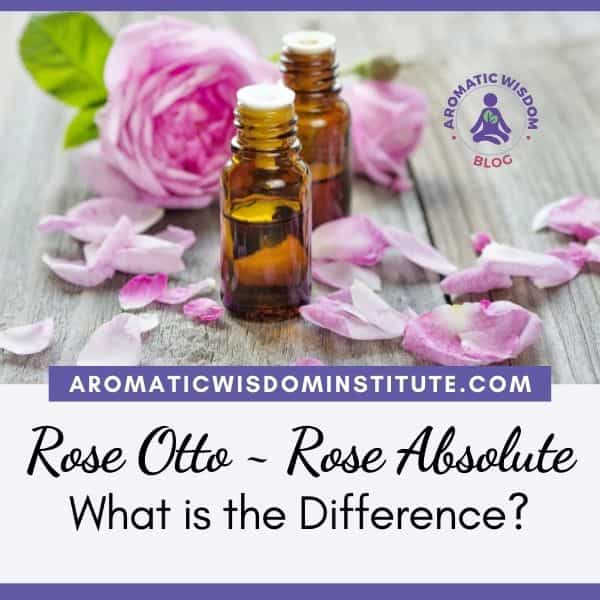In every class I teach, as soon as Rose Essential Oil is mentioned I know the question will be asked about the differences between Rose Otto and Rose Absolute, and rightly so. They are often both available from the same vendor under “Rose Oil” and many recipes will specify using one or the other. They vary in aroma, color, viscosity, and price. If you don’t know the difference, it can be very confusing. I’m here to de-confuse you.
Below is an explanation of the different methods of extractions from rose and hence, the different products born of each method.
There are four methods of extracting the essential oil from rose petals:
There are four methods of extraction from the petals of Rose flowers
1. Hydro Distillation
Rose petals (usually from the Rosa x damascena plant) are placed in the pot of a distillation unit (most likely a copper alembic still) filled with water and slowly heated. As the water warms, the flowers release their essential oil into the steam that is pushing its way through the aromatic petals. This watery mist which contains essential oils, plant acids, and other components passes through a cooling condenser and eventually empties into a glass separatory funnel Inside the glass funnel, the essential oil floats on the surface above the water portion below (the steam transformed back to the water phase once cooled). The essential oil is collected and sold as Rose Otto. The name “Rose Otto” is derived from the “attar of roses” and dates as far back as the 17th century.
The aromatic liquid that remains is called Rose Hydrosol. Rose Otto tends to have a clear to very pale yellow color and a light, gentle aroma which lends itself well to wearing it as a perfume which is my favorite way to use it! Be aware that Rose Otto becomes solid at temperatures below 21°C (69.8 °F) because the plant waxes present in the product begin to set.
2. Solvent Extraction
Solvent extraction happens in three stages, which I’ll share in a highly abbreviated version.
First, the rose petals are placed in a drum with an organic solvent, usually hexane or toluene, and rotated. This draws out the aromatic portion of the petals. When the hexane has evaporated, what remains is a thick, waxy substance called a concrete (not used by aromatherapists).
Next, the waxes and non-aromatic components are filtered out of the concrete with ethanol alcohol, leaving behind an aromatic liquid called Rose Absolute. Solvent extraction gives a greater yield than hydro-distillation which is why Rose Absolute tends to be be a bit less costly than Rose Otto. The color of Rose absolute tends to be a dark orange to red with an intense rose aroma. It is preferred by perfumers and said to be closer in fragrance to the flower than an otto.
3. Supercritical Carbon Dioxide Extraction (CO2)
This is an expensive process involving some highly sophisticated equipment, but which offers superior oil. The rose oil extracted by this is considered truest to the original fragrance in the flower and may be called an absolute but should correctly be called a CO2.






Wouldn’t the Rose Otto be better for us than Rose Absolute, because in the Rose Otto, no solvents are used in the process?
Thank you!
Cheryl
Hi Cheryl and thank you for such a GREAT question! What you brought up is often debated in the aromatherapy community. There are pros and cons to both. Yes, Rose absolute is obtained by solvent extraction, buy it’s more affordable, and in my opinion, there is so little solvent left that it isn’t enough to NOT use it. I’m sure there are more toxins on our dinner plate or what we breathe most days than the traces of solvent that MIGHT be present in Rose Absolute. Let’s say, the benefits outweight the risks.
With Rose Otto, since it is obtained through distillation, you’re correct, there will be NO solvents present at all. Also, I prefer the aroma of Rose Otto. But the cost can be prohibitive for many. I’m so glad you posed this great question Cheryl, and I’m sure others will wonder the same thing. Liz
Rose Otto has a much more beautiful scent! However I just bought a tiny bit from a different vendor on Amazon and it was not the beautiful scent that I had been getting.
Teri, personally, I would not purchase an expensive and precious aromatic like Rose Otto from Amazon, but rather a specialized supplier. I would suggest Naturesgift.com.
Hi Liz,
Are you by any chance familiar with Rocky Mountain Oils website? Wondering, if they can be trusted with purchasing Rosa Damascena Essential Oil… All the reviews there are 5*****.
Please advise. 🙂
Hi Rene, I’ve never purchased essential oils from Rocky Mountain, only from NaturesGift.com because I can obtain the GC/MS analysis with my purchase. I don’t see one offered on the RM website. If you do purchase from RM, I would be sure to ask for the GC/MS report for that batch. Many companies purchase adulterated Rose Oil, without even realizing it. That’s why I also say it’s important to develop a relationship with your supplier. And THEY should have a relationship with the distiller. If you want to get 10% off your order from NaturesGift, let me know and I’ll send you a special code. Hope this helps! Liz
What is the cost for the Rose Otto?
Rebecca, It depends on where you purchase the Rose Otto. Personally, I use Rose Absolute from NaturesGift.com because I love it and I can read the up-to-date, batch-specific GC/MS reports for every essential oil they carry. If you don’t know what a GC/MS report is, you can learn more on this blog post https://aromaticwisdominstitute.com/are-your-essential-oils-gcms-tested/ Thanks for stopping in Rebecca! Liz
Thanks Liz for sharing the info on Rose Otto & Absolute plus a recommended Essential Oil Co.
Your information is so amazingly helpful!!! Thank you for sharing your knowledge.
why isn’t there a way to get 100% rose oil with out the chemicals/solvent or it being diluted?
Jacqueline, the only way to obtain rose essential oil without heat or solvents is through critical carbon dioxide extraction. The product is then called a Rose CO2.
Hello, how should i know that the Rose absolute is genuine?
I know that the rose otto will freez at 20°c but what about rose absolute?
Hi Ahmed, It is important to know the source of the aromatics you purchase and to trust them. Beyond that I would suggest having the oil GC/MS tested to determine the purity. Hope this helps, Liz
Which process is better for the skin as far as adding or creating a facial serum to help with fine lines or firming the skin?
Hi Carin, I’m not sure what you mean by “what process”? If you mean what carrier, it does depend on the skin type. I have found that tamanu oil is great for the skin, but there are so many. With essential oils, hands down, Frankincense essential oil is the best for helping reduce fine lines and for giving maturing skin more life.
I should have said method instead of process. Do the different extraction methods affect the therapeutic properties? I would love to add rose into one of my facial serum. Thanks much!
I Love Frankincense oil. Would 1 drop mixed in with whatever oil I’m applying be too much to put on the face and neck at one time? What about with rose Otto? I like to keep the essential oils separate and just use them one drop at a time. But perhaps that’s too strong. Thanks!
Hi Marnie, 1 drop on the face of either Frankincense or Rose Otto is fine, as long as you’re blending that drop in a carrier that is nourishing for the skin, such as an organic lotion or jojoba oil or some other wonderful face-friendly oil. BTW, those are two of the most wonderful oils for the skin – well done! Liz
aside from perfume uses, is either rose oil (Otto or Absolute) good for mature skin?
Hi Ellen, Oh my yes! Both rose otto and rose absolute are wonderful for mature skin, especially when combined with Frankincense. Liz
I believe Carin was wondering the same thing I am – is otto or absolute better for a serum?
Jessica, either rose otto or rose absolute will be great in a face serum. Some people prefer otto overall since there are no chemical solvents used to extract it, but it is much more expensive. Great question! Liz
I have made quite a large investment into organic certified pure essential oils, including Rose, Frankincense, Sandalwood, Cypress Blue, Myrrh, Lavender,, Geranium, Carrot Seed , Rose Geranium & more plus a selection of carrier oils
,Almond Sweet , Avocado, Evening Primrose , Jojoba, Macadamia, Rosehip
Vitamin E
What I am now seeking is a quality serum recipe that incorporates some/all of these oils suitable for mature and aging skin . I am not seeking to compromise on product or cost as I am aiming for a superior end product
Josephine 11.09.17
Hello Liz, After reading your article and questions from the community, Im gathering Rose otto is probably the better formula to choose despite the cost correct? Any recommendations to get a 100% pure formula of trustworthy companies for the Rose otto? I am trying to combat some adult acne that I’m now just learning that what do ya know, Rose oil seems to be rather the impressive natural weaponry to holistically aid the problem. Man, I wish I had this intel when I was a teen!
Also, I hear it can be also very effective in treating anxiety & depression? Can you comment on that? Lastly, Can Rose oil be beneficial in the same manner like adding lavender drops as a tonic to a glass of water?
Is there any Rose Otto Absoluate? Not rose otto nor rose absoluate?
Hi Daisy, Nope, there cannot be “Rose Otto Absolute” because Rose Otto is expressed with distillation, and Rose Absolute is expressed with solvent. Liz
A while back I did see a Rose Otto Absolute which was a blend of 50% Rose Otto and 50% Rose Absolute meant for people who are looking for a combination of the benefits that each extraction method offers. That was over a year ago so I don’t recall the brand name but it would certainly be easy for you to make your own by purchasing 1 bottle of Rose Otto and 1 bottle of Rose Absolute and then blending them together. You will get the best results by only purchasing from a reputable supplier that offers proof of independent testing for each back produced.
Hello Madam
I use vergin olive oil instead of hexane for extraction then distill waxy material by pharma grade ethanol n produce pure oil.
GC/MS lab test is Balence.
I am right or wrong in my process I don’t know.
Is this rose oil absolute.
Please guide me madam
I share my GC/ms test report to you very shortly.
Please answer me n share your comments for better product
Thank you for sharing your process and I appreciate that you use Olive Oil instead of Hexane. As I am not a distiller I cannot say if your process is correct. I would be very interested in seeing the GC/MS report! Thank you for offering to share it with you. You can email me a copy at liz@aromaticwisdom.com.
Wonderful comments and information. I am going to bookmark this link to get the most up-to-date information. I appreciate the explanations for the Rose Oils. You answered my questions. For now! Now I can make an informaed choice. I also appreciate the links for suppliers. It is so difficult to choose where to purchase Oils as every company tells me they are the best. But I will trust your judgement.
Many thanks.
Hello Liz, and thank you for such an informative article.
I own a land by the sea, and considering harvesting rosa rugosa Hansa.
my question is how would rosa rugosa compete with rosa damascena on basis of fragrance, oil yield, market demand and price.
I will appreciate your input.
Hi Ramy, Thank you for your wonderful question. Am I am not a commerical distiller, I really don’t know. Liz
I have a question. I understand the difference between rose otto and rose absolute. But what is rose antigua?
I have always purchased my oils from AV Treasures. They don’t send the report if you order and they ship but they will upon request. Just wanted to offer up another good reliable source.